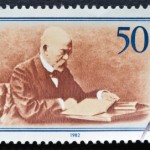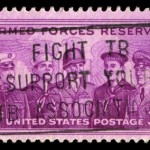In the era before antibiotics, especially in the late 19th century, tuberculosis, often called the "white plague," was a leading cause of death in the United States. Eastern patients were urged by their physicians to travel to Colorado where the fresh mountain air was supposedly curative. Hundreds of those stricken with TB went to Denver which was sometimes called "the world's sanatorium." Hospital beds were scare and a Jewish woman, Frances Wisebart Jacobs, recognized as the founder of what is today's United Way, spearheaded a movement to fund a TB hospital which eventually became National Jewish Hospital and served patents of any creed with free care for the indigent.
Prior to the advent of antibiotics, TB continued to treated in sanatoriums, where rest, fresh air (and sometimes surgical collapse of a lung or removal of a cavity) were all the therapy available. Extracts from one such patient's diary, begun in April of 1944 and continued through early June of 1946, are available online having been published in the British Journal of the Royal Society of Medicine in 2004.
Latent TB is usually treated for nine months with a single antibiotic, usually INH like I was given in the late 1970s. Active TB is quite a different matter and for those with drug-susceptible infection, usually requires a four-drug combination given for six months. This may be given as directly observed therapy with a healthcare worker meeting the patent at their home or workplace.
If the patent stops taking the antibiotics too early or if the particular TB bacteria involved are drug resistant (this occurs more frequently in people with HIV/AIDS and those who have had previous TB therapy), or the medications used are of poor quality, multi-drug resistant TB can develop.
A 2002 paper titled "Tuberculosis therapy: past, present and future," while detailing the history of TB treatment, mentions that George Bernard Shaw, in his 1911 play, The Doctor's Dilemma, talked about the early attempts to cure the disease as a "huge commercial system of quackery and poisons." Elsewhere in the play, Shaw mentions "stimulating the phagocytes," referring to white blood cells that can engulf invading bacteria. The modern take on this 1911 quote would be a TB vaccine.
The only one I'm aware of is BCG, an attenuated live viral vaccine produced from the bovine strain of tuberculosis. It's been around since the 1930s and has been given to at least 5 million people globally, but its major benefit has been to prevent spread of TB to sites other than the lungs. At this stage we really need an effective immunizing agent, as our pharmacologic attempts to keep TB in check are becoming less and less effective.
Workers at the CDC published a 2007 paper titled "Worldwide Emergence of Extensively Drug-Resistant Tuberculosis" (XDR-TB) mentioning that nearly 90 countries have had multi-drug resistant TB (MDR-TB) requiring usage of so-called second-line drugs for at least two years. Now we've gone beyond that as nearly 10% of the 3,520 samples from an international MDR-TB pool were also untreatable with a majority of those drugs.
So we're up to 2012 and The Wall Street Journal's article, "India in Race to Contain Untreatable Tuberculosis." TB already kills more people than any other infectious disease except for HIV. But since the first cases of XDR-TB were reported in Italy in 2007, Iran and now India have also been struck by the strain.
There's an urgent need for an effective vaccine or a totally new approach to TB treatment.
Tags: extensively drug-resistant TB, Frances Wisebart Jacobs, multi-drug-resistant TB, sanatorium therapy for TB, TB therapy


